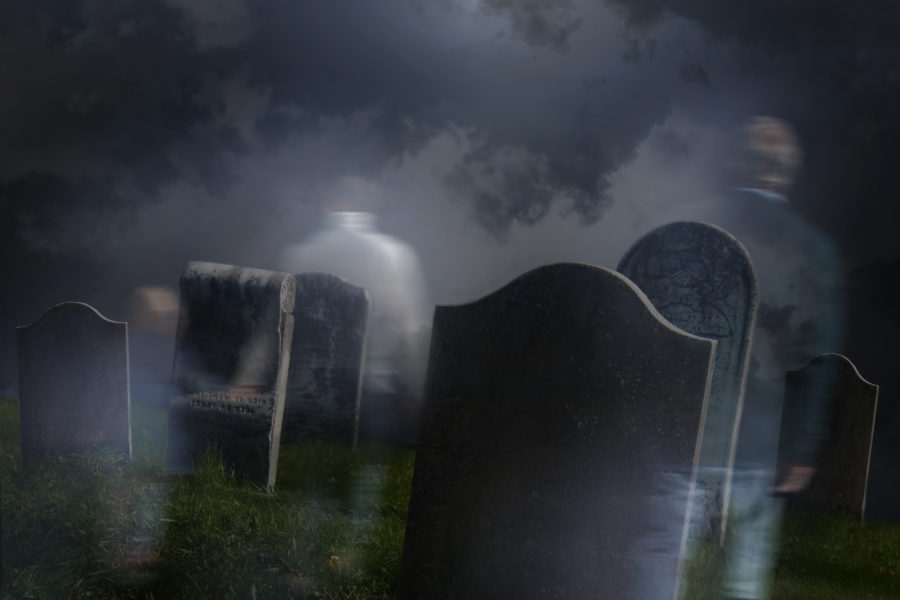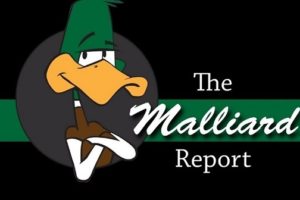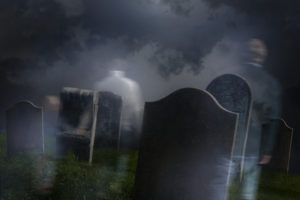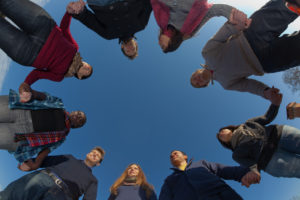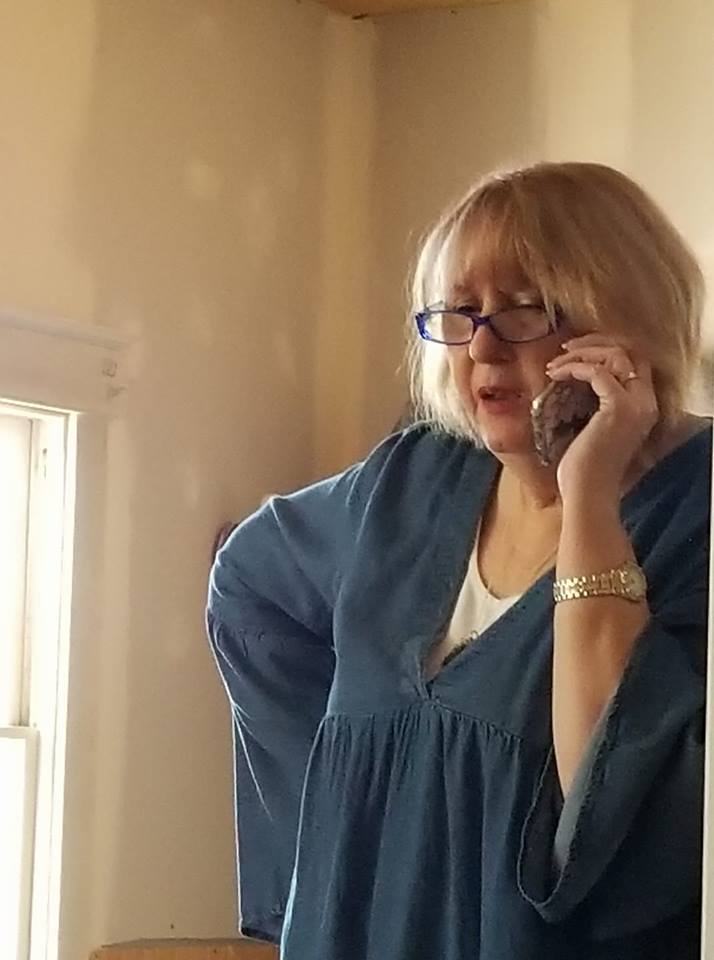As a paranormal investigator, my way of having a conversation with those who have passed into spirit is to do an EVP session.
By Rebecca Nidey
Everything I Need To Know I Learned In A Haunted House
The fact that a ghostly spirit no longer has the means to project a voice (the larynx, tongue, lungs, etc.) does not seem to deter them. Although the messages are usually brief… sometimes only a one syllable word… an EVP session can be just as enlightening, joyous, or sad as a conversation with a living person.
For those who are new to the field of paranormal research or have not delved into it in any way, the term EVP stands for Electronic Voice Phenomena. There are other means of communication with those who have left their bodies and I will touch on that in this column also.
Originally, I had planned on discussing the technical aspects of EVP, but soon realized that I don’t have a technical bone in my body, so instead, I chose to focus on those who did have that physical anomaly. Research gave me an indication of how brave, brilliant and plainly curious these people were.
In no particular order I am going to introduce you to some of these early trailblazers.
Doing many hours of research, I kept having a name crop up that should be familiar to all of us, but not in the context of the paranormal.
In an interview in the October, 1920 issue of The American Magazine, Thomas Edison was quoted as saying “I have been at work for some time building an apparatus to see if it is possible for personalities which have left this earth to communicate with us.”
In another interview the same month for The Scientific American he also said basically the same thing, but used the word “thinking” rather than “working on” but phrasing it as an apparatus or machine that could be operated by those who had passed on. No evidence of this early version of a “ghost box” has been found.
The fact that a man who was a prolific inventor and held 1,093 US patents was sure communication with the dead is possible shows that a scientific approach does not rule out the concept of the paranormal.
George Meek was an industrialist who made millions with innovations in the air conditioning industry before retiring. Because of an interest in the possibility of communication with the dead; George Meek, Paul Jones and Hans Heckman opened a laboratory in the early 1970’s which eventually became The MetaScience Foundation.
This foundation was dedicated to the study of EVP. Mr. Meek became acquainted with a psychic medium named Bill O’Neil and together they developed a device called a Spiricom (short for spirit communication). The Spiricom was supposedly refined with the help of more than twenty hours of communication that Mr. O’Neil had with a deceased American physicist, Dr. George J. Mueller.
Dr. Konstantin Raudive was both a psychologist and a parapsychologist. He developed techniques and methods to do EVP that are still being practiced today.
During the last decade of his life, he worked at recording EVP under strict laboratory protocol and conditions; collecting over 100,000 examples. Many of them seemed to be in various languages including Latvian (his native language), German and French.
Dr. Raudive started working with Freidrich Jurgenson after reading his book Voices from Space. Eventually Raudive wrote a book himself. Originally called, What is Inaudible Becomes Audible; was later re-titled Breakthrough. He had over 400 people involved in his research and all have been reported to have heard most or all of the 100,000 examples of EVP recorded under those stringent conditions.
Dr. Raudive developed techniques for recording EVP using microphones and recorders, white noise from the radio, and diodes from a crystal set not tuned to a station. Once again, a scientific mind felt that there were ways to communicate with those who had passed into spirit.
Sarah Estep was a later pioneer of EVP exploration. She promoted (and occasionally claimed to have developed) the EVP classification system actually developed by Dr. Raudive. Those classifications are:
Class A- an EVP that is very clear and audible to the human ear.
Class B- an EVP that is softer but generally plainly audible to the more trained and practiced ear.
Class C- an EVP that is more fragmented and not as easily heard but can be “cleaned up” with various computer programs developed for this use.
Mrs. Estep founded the American Association of Electronic Voice Phenomena. She became known as one of the world’s leading experts in the field of EVP research.
Sarah was introduced to death at the early age of seven during visits with her grandfather and his second wife, a funeral director, a common occurrence since they lived on the premises of the funeral home.
Often while visiting them, young Sarah would sneak into the viewing room and observe the grief stricken mourners. These experiences moved her to research whether the spirit lived on after the death of the physical body.
Her belief (a belief firmly shared by me) is that EVP is the best and most solid evidence of the afterlife of the spirit. Using her husband’s reel to reel tape recorder, she first spent five days doing sessions using the same set of questions and received no results. On the sixth day, she decided to try a new question “What is your world like?” and received the answer “Beauty.” Mrs. Estep wrote two books; Voices of Eternity and Roads to Eternity, which are must reads for all EVP enthusiasts.
Being an avid reader, most especially of any book dealing with the paranormal, I heard of an extremely interesting book several years ago. A History of Ghosts was written by Peter A. Aykroyd about his father, Samuel Augustus Aykroyd.
Samuel Aykroyd was a pioneer of spiritualism in Canada. Originally a school teacher, he became a dentist and developed an interest in the paranormal in the early 1900’s. In August of 1908, he visited Lily Dale, NY which was a spiritualist community created for psychics, mediums and those who believed in spirit communication.
After attending sessions there, he began hosting “home circles” for a small group of friends. These circles employed mediums to contact those who had passed from their mortal bodies into spirit. In a manner of speaking, this was a forerunner of the modern EVP session using mediums as the messengers rather than tape recorders or ghost boxes.
Dr. Aykroyd’s circles, as well as others, attracted many of the leading intellectuals, free thinkers, and famous of that time including Sir Arthur Conan Doyle and his wife and Alexander Fleming. As in any field, there were many cases of fraud, but Dr. Aykroyd’s sessions were held under very controlled conditions.
Spiritualism took root during the Victorian Era, named after the British monarch at the time, Queen Victoria. After the loss of her husband Prince Albert, Queen Victoria mourned so deeply that she became desperate to make contact with him. She reportedly held séances to speak to him and her interest in spiritualism soon spread around the world. A typical Victorian had an almost obsessive interest in death.
With the child mortality rate so high, as well as the short life span of the majority of the population, death was an all too familiar companion to most people of that era.
There were strict codes and procedures for people to follow during the time of mourning that covered everything from the amount of time acceptable for wearing black until a bit of color was allowed back into the wardrobe, to the fact that visiting friends or allowing visitors was prohibited for a certain amount of time .
Mourning jewelry was worn by both men and women that often included locks of hair from the deceased paired with their portraits in lockets and watch fobs. It was no wonder that the circles that Dr. Aykroyd hosted were so popular.
What set them apart, though, were the copious notes and journals that he kept. Upon his death, these notes were discovered in an old trunk in the basement of the family home by his son, Peter.
Has the last name of either of these gentlemen nagged at your memory yet? Dr. Aykroyd and Peter Aykroyd were the grandfather and father of Dan Aykroyd who co-wrote the screenplay for and starred in the movie Ghostbusters. This movie was at least in some part based on information, evidence, and events recorded in the journals and notes of Dr. Samuel Aykroyd and put into a book authored by Peter Aykroyd.
As paranormal investigators, we owe all of these people a debt of gratitude. The individuals I have written about are some of the more well known in the field of EVP research and spirit communication, but there are numerous others whose accomplishments are unsung.
However, we need to realize with every investigation we conduct we are following in their footsteps as researchers. I challenge all of you to continue this research for both ourselves and those that will follow us in this field.
About the Author:
 Through her work on the investigative team for the Crawford County Illinois Ghost Hunters, Rebecca Nidey has an understanding of the paranormal, spiritual, and metaphysical worlds and how they work together.
Through her work on the investigative team for the Crawford County Illinois Ghost Hunters, Rebecca Nidey has an understanding of the paranormal, spiritual, and metaphysical worlds and how they work together.
Rebecca has trained in the Healing Touch technique (a form of energy healing). She is a certified Psychic Medium trained by Belle Salisbury, and she is a certified Paranormal Researcher.
Rebecca is the associate editor for Bellesprit Magazine and also writes a column titled Everything I Need To Know I Learned In A Haunted House. She has been a co-host of several radio programs for the Haunted Voices Radio Network and HeyZ Radio Network highlighting the Paranormal, metaphysical and literary fields.
To learn more about Rebecca or to schedule a reading you can contact her at https://www.facebook.com/rebecca.nidey.

